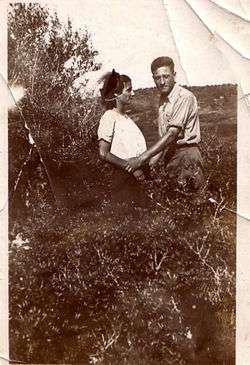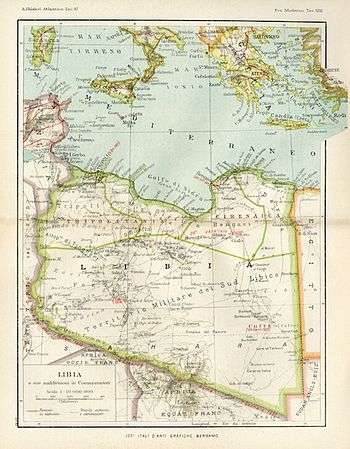Italian refugees from Libya
Italian refugees from Libya were the Italian colonists and their descendants forced to go away from Libya after the end of WWII.[2] Most of them took refuge in Italy, mainly after their 1970 expulsion ordered by Colonel Gaddafi.[3]

History
The era of international decolonization fostered an exodus of Italians from what used to be Italian Libya colony, especially after Libya became independent in the 1950s. Nearly half of the Italian colonists [4] who arrived when governor Italo Balbo brought to Libya his "Ventimilli" in 1938-1939,[5] went away in the late 1940s:[6] this first wave of refugees moved to Italy and soon most of them emigrated in the early 1950s to the Americas (mainly to Canada, Venezuela, Argentina and the United States) and to western Europe (France, Benelux, etc..).
After several years under British mandate, on December 24, 1951 Libya declared its independence as the United Kingdom of Libya (a constitutional, hereditary monarchy under King Idris). In 1952 started the exodus of most of the remaining Italian colonial settlers, mainly those in areas away from the main cities.
Although in the late 1950s most of the 110,000 Italians living in 1940 Italian Libya[7] had already left the former colony, some thousands remained (primarily farmers and craftsmen) and someone even try to participated in the political life of the new Libya.[8] King Idris was a relatively tolerant monarch, and generally treated the Italian population well: in 1964 Libya there still were 27000 Italians, of which 24000 living in the metropolitan area of Tripoli.
| Year | Italians | Percentage | Libya inhabitants | Reference |
|---|---|---|---|---|
| 1939 | 108,419 | 12.37% | 876,563 | Guida Breve d'Italia Vol. III, C.T.I. Milano, 1939 |
| 1962 | 35,000 | 2.1% | 1,681,739 | Enciclopedia Motta, Vol. VIII, Motta Editore. Milano, 1969 |
| 1982 | 1,500 | 0.05% | 2,856,000 | Atlante Geografico Universale, Fabbri Editori. Bologna, 1988 |
| 2012 | 624 | 0.01% | 3,400,000 | Ministero Interni-"AIRE". Roma, 2013 |
But after 1970 the Italian population almost disappeared when Colonel Muammar Gaddafi ordered the expulsion of all Italians colonists settlers and Jews from Libya.[9] Already in 1967, as a consequence of the Six-Day War, through an airlift and the aid of several ships, the Italian Navy helped evacuate more than 6,000 Libyan Jews to Rome in one month.[10] These jewish evacuees were forced to leave their homes, their businesses and most of their possessions behind: of these 6,000, about 4,000 soon emigrated to Israel or the United States, while the ones who remained stayed in Rome (even because they all spoke Italian and were fully integrated with the Italian way of life since 1911). Out of the approximately 15,000 Roman Jews, actually 4,000 are of Libyan descent, and constitute an influential part of the community.
Indeed in 1970, after the advent of the Libyan revolution, more than twenty thousand Italian colonists settlers in Libya were expelled suddenly from the country and suffered -like the Jews in 1967- the confiscation of all property. This was in violation of the treaty between Italy and Libya signed in 1956: this treaty was concluded on the basis of a UN Resolution of 1950, which linked the creation of the independent Libyan monarchy to the respect the rights and interests of the minorities living in the country. Some Italians of Libya wanted to organize a "resistance" political group to protect their past hegemony.[11]
The value of the assets lost by the Italians expelled has been calculated in 1970 by the Italian government in 200 billion lire for the sole real estate property value. Including bank deposits and various entrepreneurial activities, this figure exceeds 400 billion lire that equals about 3 billion euro or dollars of 2006.
The Confiscation of 1970 was justified by Qaddafi (then president-dictator of Libya) as partial relief for the damages resulting from colonization.
Regarding "Visas" in Libya, after the initial enthusiasm following the visit of the then Italian Prime Minister Silvio Berlusconi to Gaddafi in 2004, in which the problem seemed to be overcome, nearly nothing was done: up to 2011 Italian citizens repatriated in 1970 could not go back in the country until after the age of 65, through an organized trip and with the entry documents authorized both in Italian and Arabic. Even those born in Libya were denied access, as was the case of international actress Rossana Podestà who complained to have been denied the possibility of returning to her Tripoli birthplace after 1970.
In 2014 the Italian embassy in Tripoli was one of the few Western embassies still active in Libya during the Post-civil war violence in Libya due to the fact that Italy was the most important trade partner for Libya and that there were 624 Italians workers [12](of Italian companies, mainly oil related) in the country[13]
Few Italian remain in Libya. Italian refugees from Libya maintain their own organization called Associazione Italiani Rimpatriati dalla Libia (AIRL) [14] with their own magazine.[15]
Notes
- Beda's Italian colonists memories (in Italian)
- "L'associazione rimpatriati: 'Gheddafi? Un uomo che ha rovinato inutilmente la vita degli italiani in Libia'". Tiscali. Retrieved 17 November 2018.
- John, Ronald Bruce St (4 June 2014). "Historical Dictionary of Libya". Rowman & Littlefield. Retrieved 17 November 2018 – via Google Books.
- Colonial villages in Italian Libya
- "Libia. I 20.000 coloni. Istituto Luce". Retrieved 17 November 2018.
- Prestipino, Giuseppe."Les origines du mouvement ouvrier en Libye". Introduction
- Actual photos of former Italian colonists and descendants Archived 2011-03-24 at the Wayback Machine
- "13/ Fuori dal regime fascista: organizzazioni politiche degli italiani a Tripoli durante la fase postcoloniale (1948-1951)". Diacronie. Retrieved 17 November 2018.
- Bo, Massimo Russo - Patrizia Dal. "HISTORY AND main facts happende in Libya". www.tripolini.it. Retrieved 17 November 2018.
- Gruber, Ruth Ellen:"Unknown immigration from Libya has swelled ranks of Italian Jewry Archived 2005-12-19 at the Wayback Machine" in JTA October 11, 2004
- "Photo of the first expulsions in 1970". Retrieved 17 November 2018.
- "I servizi demografici". Dipartimento per gli affari interni e territoriali. Retrieved 17 November 2018.
- "Archived copy". Archived from the original on 2014-08-15. Retrieved 2014-10-13.CS1 maint: archived copy as title (link)
- "AIRL - Il sito ufficiale dell'Associazione Italiani Rimpatriati dalla Libia". www.airl.it. Retrieved 17 November 2018.
- "Rivista Italiani d'Africa". Retrieved 17 November 2018.
Bibliography
- Del Boca, Angelo. The Italians in Libya, from Fascism to Gaddafy. Editoriale Laterza. Bari, 1991
- Fuller, Mia. Preservation and Self-Absorption: Italian colonization and the walled city of Tripoli, Libya in BEN GHIAT Ruth, FULLER Mia, "Italian colonialism". Palgrave Macmillan. New York, 2008
- Metz Chapin, Hellen. Libya: A Country Study. Washington: GPO for the Library of Congress, 1987.
- Prestipino, Giuseppe. Les origines du mouvement ouvrier en Libye (1947-1951) Annuaire de l’Afrique du Nord, XXI/82, Centre National de la recherche scientifique. Paris, 1982
